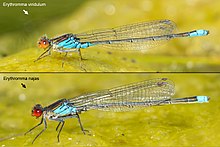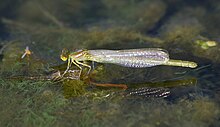Little shell eye
| Little shell eye | ||||||||||||
|---|---|---|---|---|---|---|---|---|---|---|---|---|

Lesser Grenade Eye ( Erythromma viridulum ), male |
||||||||||||
| Systematics | ||||||||||||
|
||||||||||||
| Scientific name | ||||||||||||
| Erythromma viridulum | ||||||||||||
| ( Charpentier , 1840) |
The little garnet eye ( Erythromma viridulum ) belongs to the family of the slender dragonflies (Coenagrionidae). It is considered a Mediterranean element of fauna and flies in Central Europe from June to September, i.e. on average a little later than the greater northern widespread great garnet eye ( Erythromma najas ), with which it can also be associated.
features

The species is very similar to the Great Grenade Eye. Compared to this, Erythromma viridulum is about five millimeters shorter at about 30 millimeters, but this is not particularly noticeable. Instead, the males can be distinguished by the drawing on the top of the tenth (last) abdomen segment in the form of a black “X”. In addition, the sides of the second and eighth abdomen segments in the lesser garnet eye are blue. It can also be observed more frequently that seated males bend the abdomen slightly upwards, which is not the case with Erythromma najas . In the female, the abdominal segments are four to eight yellow-green, while the segments in front and behind are blue-green. The rear edge of the prothorax of the female lacks the bulges typical of the other species. The compound eyes of the males of Erythromma viridulum are red, those of the females are brown above and greenish yellow below.
Distribution and way of life
The lesser garnet eye is a holomediterranean, warmth-loving species. A spread and population increase in connection with climate change has been recorded for some dragonfly species, including the lesser shell eye. This species is currently no longer on the German Red List. Like all native dragonflies, the species is nevertheless "specially protected" by the Federal Species Protection Ordinance.
The lesser shell's eye is almost entirely in the diving leaf zone, i. H. close above the open water surface of standing or slowly flowing waters with floating leaf vegetation (e.g. yellow pond rose ) or diving leaf plants coming to the surface, and is only rarely found in the bank vegetation. The eggs are laid in "tandem formation" in floating parts of the plant, such as shoots of rough horn leaf ( Ceratophyllum demersum ), milfoil ( Myriophyllum spp.) Or spawning herb ( Potamogeton spp.).
The larvae climb to hatch not up out of the water like other Coenagrionidae on vertical plant parts. Rather, they look for leaves or floating algae floss on the surface of the water.
literature
- Heiko Bellmann : Observe dragonflies - determine. Naturbuch Verlag, Augsburg 1993, ISBN 3-89440-107-9 .
- Gerhard Jurzitza: The Kosmos dragonfly guide . The species of Central and Southern Europe. Kosmos Verlag, Stuttgart 2000, ISBN 3-440-08402-7 .
Individual evidence
- ↑ a b H. Hunger: Biocenological studies on the habitat scheme of the lesser granatae (Erythromma viridulum (Charpentier 1840)) in the southern Upper Rhine Plain. In: Nature Conservation Southern Upper Rhine. 1998, pp. 149-158.
- ↑ M. Winterholler: Red List of Endangered Dragonflies (Odonata) Bavaria. Bavarian State Office for the Environment (BayLFU), Augsburg 2003. ( PDF online)
- ↑ M. Binot, R. Bless, P. Boye, H. Gruttke, P. Pretscher (Eds.): Red List of Endangered Animals in Germany. (= Series of publications for landscape management and nature conservation. 55). 1998.

